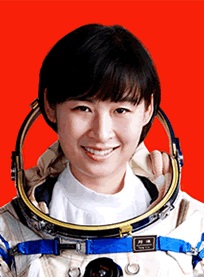Who Is China's First Female Astronaut?

China will launch its Shenzhou-9 manned spacecraft Saturday in hopes of carrying out the country's first manual orbital docking test. On board the Shenzhou-9 will be another first: the Sally Ride of China.
Liu Yang, a 34-year-old fighter pilot, will become China's first female astronaut to travel into space. After conquering a rigorous selection process and completing two years of intense astronautic training, she will join two male crewmates, Jing Haipeng and Liu Wang, on the upcoming mission.
Aside from fulfilling the mission tasks, which include rendezvous and docking with the orbiting Tiangong 1 (Heavenly Palace) module, a prototype of a proposed Chinese space lab, Liu Yang "yearns to experience the wondrous, weightless environment of space, see the Earth and gaze upon the motherland," she told the press Friday.
But who is Liu, and how — from among half a billion Chinese women — was she chosen to be the country's first space heroine? [Infographic: Female Space Explorers]
Liu lives in Beijing, but hails from the central Chinese province of Henan, a relatively poor but heavily populated agricultural region. According to Xinhua, the official state news agency, she is an eloquent speaker, an avid reader and a lover of cooking. She is also married, as per the China space program's requirements. According to the newspaper China Daily, female Chinese astronauts must be married and preferably be mothers, because of concerns that higher levels of radiation in space would "harm their fertility."
Liu began reaching for the skies just after high school, when a teacher persuaded her to enroll in an aviation school. Since enlisting in the People's Liberation Army (PLA) Air Force in 1997, she has logged 1,680 hours of flight time, earning the rank of major and deputy head of a flight unit. State media once praised her courage after she safely landed her fighter jet following a collision with a bird that covered the cockpit glass with blood, Reuters reported. She also won first place in a military speech contest.
The pilot was recruited into China's second class of prospective astronauts in May 2010. After two years of arduous training, she excelled in testing — Chinese astronauts must score perfectly on a series of tough examinations — and was selected this March as a candidate to crew the Shenzhou-9.
Sign up for the Live Science daily newsletter now
Get the world’s most fascinating discoveries delivered straight to your inbox.
Her selection quickly became the most trending subject on the country's Twitter-like microblogging service Sina Weibo, with 33 million posts. One user wrote, "Liu Yang, on the eve of becoming our first woman is space, is the pride of Henan." [7 Notable American Astronauts]
At Friday's press conference, Liu addressed her fans: "I am grateful to the motherland and the people. I feel honored to fly into space on behalf of hundreds of millions of female Chinese citizens."
Wu Ping, spokeswoman for China's manned space program, said having Liu Yang on board will not only help the country's aspiring space program test equipment designed for women in preparation for the building of an orbiting space station, but it will also expand the social impact of human space missions. Echoing a famous Chinese proverb, Ping said, "Women hold up half the sky. Human space missions without women are incomplete."
Follow Natalie Wolchover on Twitter @nattyover. Follow Life's Little Mysteries on Twitter @llmysteries. We're also on Facebook & Google+.
Natalie Wolchover was a staff writer for Live Science from 2010 to 2012 and is currently a senior physics writer and editor for Quanta Magazine. She holds a bachelor's degree in physics from Tufts University and has studied physics at the University of California, Berkeley. Along with the staff of Quanta, Wolchover won the 2022 Pulitzer Prize for explanatory writing for her work on the building of the James Webb Space Telescope. Her work has also appeared in the The Best American Science and Nature Writing and The Best Writing on Mathematics, Nature, The New Yorker and Popular Science. She was the 2016 winner of the Evert Clark/Seth Payne Award, an annual prize for young science journalists, as well as the winner of the 2017 Science Communication Award for the American Institute of Physics.











